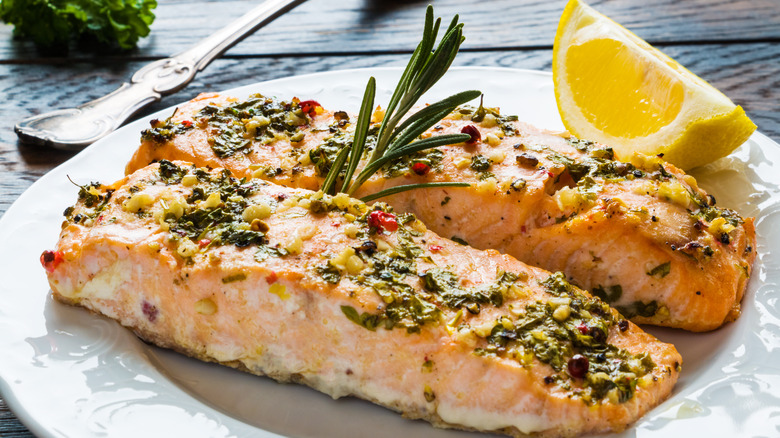For The Best Oven-Roasted Fish, Think Low And Slow
It can be hard to find a dietary plan that's easy to stick with. One way to make things a little bit easier though is to find one that includes, or even depends on, delicious foods. GoodRX Health says that one such diet is the Mediterranean diet. Undoubtedly, one of the easiest aspects of this diet is that it requires enjoying fish for a meal at least twice a week. The Washington State Department of Health says that fish is considered a healthy dietary staple because it is a highly lean source of protein, and contains tons of healthy fatty acids as well.
Not only will adding more fish to your diet give you those nutritional benefits, but it gives you tons of variety between all the different types of fish to enjoy as well. One of the biggest challenges with preparing fish, however, is keeping it from drying out.
According to Prevention, one of the most common mistakes made when cooking fish is overcooking. Most fish filets are quite delicate, and can't always take the same high-heat treatment as a thick cut of steak. Thankfully, there is an easy (and delicious) method that will help prevent this.
Benefits of low and slow cooking
One of the easiest ways to prepare fish is under low heat. Chef Samin Nosrat writes in her book "Salt, Fat, Acid, Heat," that using a softer heat when preparing fish helps to prevent overcooking (via The Washington Post). Roasting a delicate white fish filet in the oven at 250 degrees significantly lowers the chances of you overcooking your fish because it raises the internal temperature at a much slower rate. Sadly, this does mean a cooking time of roughly 35 to 40 minutes depending on the cut of the fish, but your patience will also be rewarded by a juicy and delicate meal. Unilateral cooking is another great method for slowly preparing a delicate and delicious fish dinner.
Nosrat adds that this method works especially well with fattier cuts of fish like salmon. That abundant fat will render as the fish cooks, and add a boost of flavor.
It should be noted that the United States Department of Agriculture recommends cooking fish to an internal temperature of at least 145 degrees Fahrenheit, but this might be overdoing it for many fish. Harold McGee writes in "On Food and Cooking" that most fish will start to tighten up and release their moisture around 120 degrees (via The Washington Post). That means that it's best to remove the fish from heat and let its internal temperature rise on its own before it dries out.
Fish to cook in a hurry
Knowing how you want to cook your fish is one important thing to remember when buying fish. If you're not going to have time for the low and slow method, then you'll want to make sure you're buying the right fish to stand up to higher heat.
BBC goodfood claims that one way to handle this is to use the Japanese cooking method known as tataki. This means that the tuna steaks are quickly seared, and left mostly raw in the middle. Because tuna is a fattier fish it is able to stand up to this direct heat cooking approach. Searing its exterior also gives a beautifully crisp umami flavor while leaving the delicate and rich insides mostly untouched.
The Healthy Fish says that tuna will also stand up to the high heat of a grill as well if you want to take your fish outside. Other great fish for this include mahi-mahi and salmon, which are also both thick and fatty types of fish that will tolerate high heat without drying out. Just keep an eye on their internal temperature, or you'll be left with fish jerky coming off the grill.


